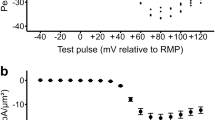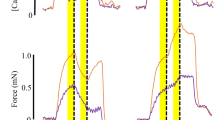Abstract
It has been proposed1 that an influx of calcium ions into twitch muscle fibres during an action potential might initiate contraction. However, when external Ca2+ is lowered to 10−8 M with EGTA, the fibres can produce normal twitches for many minutes2,3. Nevertheless, a clear Ca2+ influx during contraction has been demonstrated4,5, and it has been found that phasic skeletal muscle has an inward calcium current (ICa)6,7 which can give rise to calcium spikes8. In certain conditions, a reduction in external Ca2+ with 80–90 mM EGTA results in reversible blockade of excitation–contraction (e–c) coupling9, leading some authors to suggest7,9–11 that extracellular Ca2+ moved into the myoplasm due to ICa may be involved in the e–c coupling mechanism that triggers contraction. This proposition was further supported by the localization of ICa in the T-system, which circumvented the problem of the delay due to calcium diffusion from the surface membrane. We have now investigated whether ICa has a clear role in initiating or sustaining contractions in twitch muscle fibres. Our approach was to decrease or eliminate ICa with the calcium-blocking agent diltiazem (Herbesser) and to see how the twitch, tetanic and potassium-contracture tensions were affected. We found that ICa could be decreased or cancelled with the calcium-blocking agent, but that the same concentration of the drug potentiated the twitch, tetanus and contractures. We conclude, therefore, that ICa has no role in e–c coupling. A preliminary report of these results has been presented elsewhere12.
This is a preview of subscription content, access via your institution
Access options
Subscribe to this journal
Receive 51 print issues and online access
$199.00 per year
only $3.90 per issue
Buy this article
- Purchase on Springer Link
- Instant access to full article PDF
Prices may be subject to local taxes which are calculated during checkout
Similar content being viewed by others
References
Sandow, A. Yale J. biol. Med. 25, 176–201 (1952).
Armstrong, C. M., Bezanilla, F. M. & Horowicz, P. Biochim. biophys. Acta 267, 605–608 (1972).
Lüttgau, H. Ch., & Spiecker, W. J. Physiol., Lond. 296, 411–429 (1979).
Bianchi, C. P. & Shanes, A. M. J. gen. Physiol. 42, 803–815 (1959).
Curtis, B. A. J. gen. Physiol. 50, 255–267 (1972).
Stanfield, P. R. Pflügers Arch. ges. Physiol. 368, 267–270 (1977).
Sanchez, J. A. & Stefani, E. J. Physiol., Lond. 283, 197–209 (1978).
Beaty, G. N. & Stefani, E. Proc. R. Soc. B194, 141–150 (1976).
Barrett, J. H. & Barrett, E. F. Science 200, 1270–1272 (1978).
Potreau, D. & Raymond, G. J. Physiol., Lond. 307, 9–22 (1980).
Nicola Siri, L., Sanchez, J. A. & Stefani, E. J. Physiol., Lond. 305, 87–96 (1980).
Gonzalez-Serratos, H., Valle-Aguilera, R., Lathrop, D. A. & Garia, M. C. VII Int. Biophys. Congr. (IUPAB, 1981).
Hille, B. & Campbell, D. J. gen. Physiol. 67, 265–293 (1976).
Gonzalez-Serratos, H. J. Physiol., Lond. 253, 321–339 (1975).
Fleckenstein, A. A. Rev. Pharmac. Tox. 17, 149–166 (1977).
Lathrop, D. A., Valle, R., Gaum, W. E., Schwartz, A. & Kaplan, S. J. molec. cell. Cardiol. 13, 111–115 (1981).
McDonald, T. F., Pelzer, D. & Trautwein, W. Pflügers Arch. ges. Physiol. 385, 175–179 (1980).
Ehara, T. & Kaufman, R. J. Pharmac. exp. Ther. 207, 49–55 (1978).
McCleskey, E. & Almers, W. Biophys. J. 33, 33a (1981).
Author information
Authors and Affiliations
Rights and permissions
About this article
Cite this article
Gonzalez-Serratos, H., Valle-Aguilera, R., Lathrop, D. et al. Slow inward calcium currents have no obvious role in muscle excitation–contraction coupling. Nature 298, 292–294 (1982). https://doi.org/10.1038/298292a0
Received:
Accepted:
Issue Date:
DOI: https://doi.org/10.1038/298292a0
This article is cited by
-
Voltage sensing mechanism in skeletal muscle excitation-contraction coupling: coming of age or midlife crisis?
Skeletal Muscle (2018)
-
The Ca2+ influx through the mammalian skeletal muscle dihydropyridine receptor is irrelevant for muscle performance
Nature Communications (2017)
-
Stac3 is a component of the excitation–contraction coupling machinery and mutated in Native American myopathy
Nature Communications (2013)
-
Enhanced dihydropyridine receptor calcium channel activity restores muscle strength in JP45/CASQ1 double knockout mice
Nature Communications (2013)
-
Reversible congestive heart failure in severe hypocalcemia
Herz (2010)
Comments
By submitting a comment you agree to abide by our Terms and Community Guidelines. If you find something abusive or that does not comply with our terms or guidelines please flag it as inappropriate.



